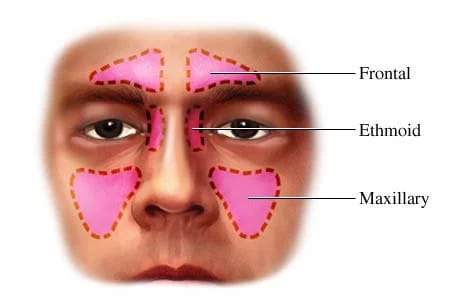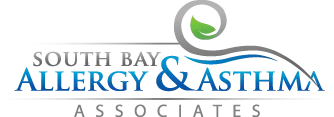What are sinuses?
The sinuses are air-filled cavities located within the bony structures of the cheeks, behind the forehead and eyebrows, and behind the nose directly in front of the brain.

Normal sinuses continually produce a very thin layer of clear mucus that helps trap bacteria, viruses, dust particles, and other airborne irritants that we all breathe in each day. Tiny hair-like projections on the surfaces of the sinus cavities (cilia) function as our own inborn filtration system and sweep these unwanted particles out through sinus openings into the nose or down the throat into the stomach. In addition to being an internal vacuum, the sinuses also provide a cushioning effect to head structures ("shock absorbers" if you will).
What is sinus disease?

The most common form of sinus disease results from a "blockage" that interferes with the normal drainage pattern. Imagine bacteria or viruses building up inside closed, or blocked, cavities with nowhere to drain. Infected mucus will accumulate inside one or more sinus cavities and result in a sinus infection (sinusitis). Most sinus infections will clear spontaneously without specific treatment. In fact, the majority of people have probably had more than one sinus infection in their lifetime as a complciation of a common "cold" without even knowing it. Repeated sinus infections, or a more severe infection that goes untreated, can become "chronic" in nature. That is, the symptoms are lasting for more than a month to 6 weeks. We call this chronic sinusitis. Chronic sinusitis is a fairly common complication of allergic rhinitis (hay fever). Nasal and sinus tissue swelling results from the body's allergic response to airborne allergens. An allergist can help sort out the cause and provide the necessary treatment to control the underlying allergies, thereby reducing the number of sinus infections. Rarely, some people will develop nasal and sinus polyps (benign growths that contain mucus) that can also obstruct sinus passages and lead to chronic sinus inflammation.
How do I know if I have a sinus infection?
The most common symptoms of a sinus infection include: facial pain overlying the sinus cavities, a thick green or yellow/brown nasal discharge, headaches, and fatigue. It is especially important to seek the advice of a physician if the symptoms continue for more than 4 weeks after the typical cold symptoms have resolved. If you do not respond to treatment, it is sometimes necessary to obtain a CT scan of the sinuses to help diagram the extent of disease.
How is sinusitis treated?
Most importantly, it is important to establish the proper diagnosis. Antibiotics, in conjunction with measures that promote drainage ("rinsing" the sinus cavities, steroid sprays with small amounts of steroids, and mucus thinning agents) usually work to clear most infections. If you have been on repeated antibiotics and the symptoms persist, it is important to have a more extensive evaluation to see if you have a fungal sinusitis, polyps, nasal allergies, or some other abnormailty preventing healing. Rarely, surgery is required to "clean out" the sinuses and reestablish adequate drainage.
